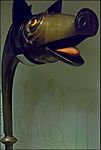Carnyx
| Carnyx |
|---|
 En carnyx på ett franskt museum
|
En carnyx[uttal saknas] är ett blåsinstrument av brons som var vanligt hos de forntida kelterna[1] under järnåldern och som användes mellan cirka 200 f.Kr. och cirka 200 e.Kr.
Instrumentet är en typ av bronstrumpet formad i en förlängd S-form och som vid användning hölls vertikalt. Öppningen var formad som huvudet på ett djur, till exempel ett vildsvin. Instrumentet användes vid krig, troligen för att mana trupper till strid och, som Polybios återberättade, för att skrämma motståndare.
Bildgalleri
Användning
Illustration ur De Bello Gallico
Mynningen på en carnyx hittad vid en gallisk begravningsplats vid Tintignac.
En replik i Skottlands nationalmuseum.
Referenser
- Den här artikeln är helt eller delvis baserad på material från engelskspråkiga Wikipedia.
Noter
- ^ "carnyx", Nationalencyklopedin. Åtkomst den 28 maj 2016
Externa länkar
 Wikimedia Commons har media som rör Carnyx.
Wikimedia Commons har media som rör Carnyx.
Media som används på denna webbplats
Mannequin representing an aide-de-camp of the Aeduan chief Dumnorix. Celtic Civilization Museum, Bibracte, France.
Författare/Upphovsman: Kabuto 7, Licens: CC BY-SA 3.0
A modern reenactor portraying an Ancient Celt (Vacomagi tribe, a.k.a Caledonian/Pict/Briton) with carnyx trumpet, crested helmet, chain mail (chainmaille), and woad circa 100-300 AD. The carnyx was used for war (signaling and intimidation), and ritual occasions as depicted on the Gundestrup cauldron. The costume, helmet and appearance were inspired by contemporary depictions and written accounts.
Författare/Upphovsman: dun_deagh, Licens: CC BY-SA 2.0
National Museum of Scotland.
In 1816, near Deskford, Moray, the remains of a Celtic war trumpet called a carnyx were discovered. It was thought to have been made between 80 to 200 AD.
This is a replica of that trumpet made in 1992. It's made mainly from bronze and brass. The tongue is of wood and the eyes are enamel. It is 1.66m in length.
It was found in a peat moss; according to archaeologists it was probably a sacrificial offering to the gods.Författare/Upphovsman: Kabuto 7, Licens: CC BY-SA 3.0
Sound of the carnyx: a 5-6 feet tall, bronze/brass trumpet, held vertically, with a bell shaped like a boar, dragon, or serpent. Carnyx were played by the Ancient Celts (Caledonian/Picts, Briton, Albion) and Gauls, circa 300 BC – 300 AD. The carnyx was used for war (signaling and intimidation), and ritual occasions as depicted on the Gundestrup cauldron.
Carnyx were employed in battles including Mons Graupius, Boudicca’s rebellion (Camulodunum, Londinium, Watling Street), Siege of Alesia, Mons Graupius, Bibracte, Gergovia, attack of Delphi in 279 BC.
Pitch changes are made via embouchure on the trombone-sized mouthpiece. Played and recorded by Kabuto 7Författare/Upphovsman: Claude Valette, Licens: CC BY-SA 3.0
Carnyx found in the Gallic sanctuary of Tintignac (Corrèze). Cité des Sciences et de l'Industrie (Paris), "Les Gaulois, une expo renversante", from 19-10-2011 to 02-09-2012.
Författare/Upphovsman: Internet Archive Book Images, Licens: No restrictions
Identifier: caesarsgallicwar00caes (find matches)
Title: Caesar's Gallic war; (Allen and Greenough's ed.)
Year: 1898 (1890s)
Authors: Caesar, Julius
Subjects:
Publisher: Boston, Ginn & co.
Contributing Library: Internet Archive
Digitizing Sponsor: Internet Archive
View Book Page: Book Viewer
About This Book: Catalog Entry
View All Images: All Images From Book
Click here to view book online to see this illustration in context in a browseable online version of this book.
Text Appearing Before Image:
i*venire ; imperio populi Romani non modo de regno, sedetiam de ea quam habeat gratia, desperare. Reperiebat ^etiam in quaerendo* Caesar, quod proelium equestre adver-sum paucis ^ ante diebus esset factum, initium ® (eius) fugae 20 factum a Dumnorige atque eius equitibus, — nam equitatui,quem auxilio Caesari Haedui miserant, Dumnorix praeerat;eorum fuga reliquum esse equitatum perterritum. Caesar Thinks that Dumnorix should be Punished. 19. Quibus rebus c5gnitis, cum ad has suspiciones certis-simae res accederent, — quod per finis Sequanorum Helve-25 tios traduxisset, quod obsides inter eos dandos curasset,®quod ea omnia non modo iniiissii suo et civitatis sed etiaminscientibus ipsis fecisset, quod a magistratu Haeduorumaccusaretur, — satis esse causae arbitrabatur^ qua re in Cf. 1 finitimos, p. 8,1. 20. — 2 obtinere, 15, 9- — reperit, 15, 23.— * quaerit, 15, 23. — ^ ^dMiZl, 13,7- — ^initium, 2, i. — ^ praeerati14, 4. — * curat, II, 5. — • arbitrantur, 4, 15.
Text Appearing After Image:
Fig. II. —Gallic Remain.s. I and 3. Necklaces with amber and coral peadants. 2. Military standard. 4 Bronretrumpet (carnyx). 5. Iron boss of shield. 6, Iron holder. 7. Sword-hilt andgirdle. 8. Iron helmet. 9. Iron belt-chain. B. G. I. 20.) Campaign against the Helvetii. 17 eum aut ipse animadverteret aut civitatem animadvertereiuberet. But Summons Diviciacus, Whom he does not Wish to Offend. His omnibus rebus unum repugnabat, quod Diviciaci fratrissummum in populum Romanum studium, summam in sevoluntatem/ egregiam fidem, iustitiam, temperantiam cogno- 5verat : nam ne eius supplicio Diviciaci animum offenderetverebatur. Itaque prius quam quicquam conaretur,^ Divi-ciacum ad se vocari iubet, et cotidianis^ interpretibusremotis per C. Valerium Procillum, principem * Galliaeprovinciae, familiarem suum, cui summam omnium rerum 10fidem habebat, cum eo conloquitur; simul commonefacitquae ipso praesente in concilio (Gallorum) de Dumnorigesint dicta; et ostendit^ quae separatim quisque de eo
Note About Images








